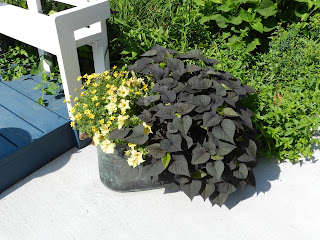 |
Horseradish in my garden
is the big leaves
in the left middle of this photo. |
If you talk about a locally grown hot spicy vegetable,
peppers come to mind. Today I’m going to
talk about another great spicy plant:
horseradish.
Every garden used to have a horseradish plant. It was
a way to add flavor to meats that may have been processed or cooked to the
bland stage. Today, few homeowners would
know the horseradish plant, let alone know how to make it into the rich
wonderful condiment they find in the refrigerator section at the grocery.
Horseradish (Armoracia rusticana – Cochlearia) is a
perennial plant belonging to the Brassicaceae family (that includes mustard and
cabbages.) It’s cold tolerant to Zone
4.
We assume it arrived in the US with immigrating
Europeans. It’s a staple of German
cooking and a root would transport easily by sea tucked into a steamer
trunk. Today it’s popular around the
world.
The plant grows with large palm shaped leaves reaching up to
five foot. It’s not invasive although it
slowly expands its footprint. Digging
some of the roots annually will keep it healthy and in check.
The horseradish root itself has hardly any aroma. When cut or grated the enzymes from the
damaged plant cells breakdown sinigrin (a glueosinolate) to produce allyl
isothiocyanate (mustard oil.)
Horseradish may be harvested in the spring or fall although
cooks definitely have a preference because the flavor is more pungent in the
fall.
 |
| Horseradish roots |
Anyone who’s taken that white root, peeled the outside with
a carrot peeler and tried to grate Horseradish will have stories to tell that
rival any cooking experience. As the
mustard oil is released, anyone within a few feet will have their sinuses and
eyes irritated unless extraordinary precautions are taken.
Most people process Horseradish outside. I have friends who have “horseradish
processing apparel”. It consists of
goggles and some even so far as a sealed headgear. Others swear by using a food processor or
blender. All use rubber gloves when
handling the raw root because it can blister the skin.
If it has all these scary attributes, why do we even
bother? Because it adds such wonderful
spice to our meals. It’s especially
valued with beef and always an ingredient in cold seafood sauce. Some old recipes call for using the leaves in
salads but I’m thinking it would be a little like eating hay.
Whatever your method, the grated Horseradish must be
immediately mixed with vinegar or it looses its pungency and becomes
unpleasantly bitter when exposed to air and heat. It’s best to put in sterilized jars and kept
in the refrigerator. It can then be
used mixed with other ingredients or simply as is.
Horseradish is grown commercially and as such is treated as
an annual. Annually grown plants tend to
have more tender creamy white roots. It
should be planted in early spring and can be grown in almost any soil except
sand and heavy clay. If your local
nursery doesn’t carry the plant, look on-line or in catalogs or dig a root from
a friend.
 |
| Horseradish in bloom |
Use only the tender white roots, as the old ones are tough
like wood pith. Recipes are usually
found in very old cookbooks. Some
recipes add so many additional ingredients; it masks the zing and essence we so
love.
It was used (back in the day) as a means of clearing the
sinuses. And whoa baby, eating a half-teaspoon
can power its way through your sinus cavities like a blowtorch. My advice, if you’ve never eaten fresh
Horseradish, takes it a little slow and in small portions. You’ve been warned!
If you’ve never eaten fresh ground Horseradish, it’s like so
many things – it’s another taste altogether.
Examples: Fresh tomatoes from the garden vs.
hothouse. Peaches fresh from the tree
vs. commercially canned. Sweet corn
from a farmer’s field vs. frozen in a bag.
It’s a wonderful
garden plant; needs little care or extra effort. The leaves have a beautiful tropical look
without the fragility. Best of all, it
is a wonderful food. Now gather your
goggles and get grating!
.JPG)
.JPG)
.JPG)
.JPG)
.JPG)
.JPG)
.JPG)

.JPG)









.JPG)

.JPG)




